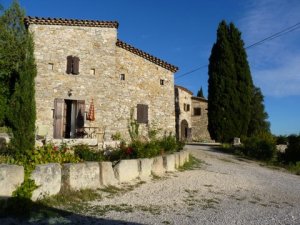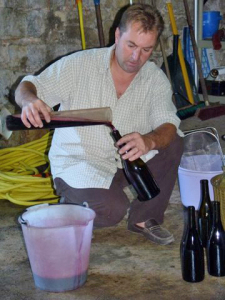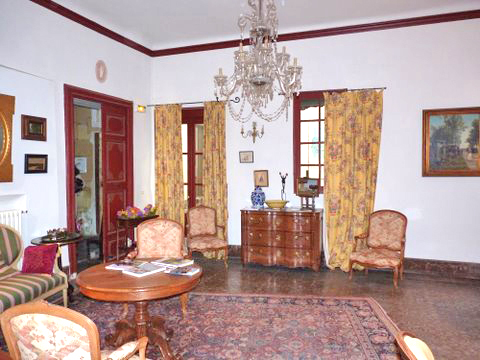
text and photos ©2011 by Bill Marsano
Languedoc-Roussillon is almost invariably short-changed. It’s blessed by lovely, lively Nîmes and dramatically walled Carcassone, but Provence just across the Rhone gleams with Avignon, Arles and Aix, with gritty Marseille and belle époque Nice, with the Côte d’Azur’s beaches, pebbly and topless. Its name is almost invariably abridged to ‘the Languedoc’, but don’t you give it short shrift. It is to Provence as Sonoma is to Napa and, to me, irresistible. Thus in October I returned from a visit with some defiantly unpasteurized cheeses in my luggage and many warm memories. The latter I will readily share, more or less at random, but don’t get too close to my cheese.
I began in Montpellier. The region’s capital, it styles itself a go-ahead, modernetechnotropolis, so I stayed at the supercool Novotel Antigone, briskly efficient and possibly unique in combining reception, cocktail lounge, massage parlor, sitting room, newsstand and snack center in a single space. I even visited l’Esplanade de l’Europe, where I dined at Le Sud, a casual café. It offered good few-euro galettes, tapas and salads, and service that ranged from slapdash (mine) to military (a waiter told a large group to pay attention when he recited the specials because he would not repeat them).
On L’Esplanade a dozen-or-so restaurants blaze with lights, but they’re its sole signs of life. The tourist office preens itself on l’Esplanade, but look around and you’ll see you’re about the only one there. It’s not a human and humane plaza but a grandiose and soulless Urban MaxiMegaMonster development on the order of La Defense, in Paris. Here a star-quality architect (Barcelona’s Ricardo Bofill) used more money than genius to create a windy and alienating De Chirico landscape. In l’Esplanade, people are mere specks among huge, oppressive buildings that stare blank-faced across vast, cold, empty acres. Le Lez is a pretty rural wrinkle of a river in the countryside; here it’s been brutalized into a “water feature”—a lifeless canal whose concrete banks feature more cars and trucks than strollers and lovers.
Montpellier has more and better, no doubt, but I did not tarry. Urbanly alienated, I sought small towns and big skies, sunny vineyards and Roman relics.

A view of Sommières from the north
My first relique romain turned up in Sommières, a little jewel 20 miles or so west of Nîmes, which had let me down. Nîmes’ main square was an off-season construction site and the Maison Carrée was cloaked for restoration, but Lysianne Boissy d’Anglas, a friend in the Gard tourist office, saved the day. “You’ll fall in love with Sommières,” she said, and I did, at first sight. So, in fact, did the nominally British novelist Lawrence Durrell, who lived there 33 years and said he’d seen no prettier town.

The garden entrance of Hôtel de l’Orange
Sommières is an ancient Roman town of four beauties. The first of these is the indolent river Vidourle, which nods peacefully along between its shady banks. The second is a fine arched bridge built during the reign of the Emperor Tiberius. Third is the Saturday market, held in a tree-ringed and sunken courtyard whose arcade is the land-bound end of the bridge. I admit to being a sucker for almost any market at all, but this one is especially fine for its intimate setting.

Bedroom at Hôtel de l’Orange
The final treasure of Sommières is the Hôtel de l’Orange, which lives in an atmospheric and homey building erected in 1610 and owned, lovingly it’s clear, by only three families in the four centuries since. Pressed into the flank of a hill (itself crowned by a ruined castle), the hotel overlooks the church and tile roofs of the medieval quarter. It is serene in its graveled forecourt and garden full of trees and greenery; it’s comfortably small (10 rooms plus one apartment) and, save for the plumbing and the rooftop pool and terrace, l’Orange is refreshingly unmodernized.
As much can be said for Philippe de Frémont, l’Orange’s owner, a gentle and courtly man for whom the term “old school” might have been created. He’s always available at breakfast to suggest what to see in the town and its environs, and to tell of this history of his home. There is, in fact, rather a lot to tell: M. Frémont is from a Sommières family that dates to 1254 and Philippa d’Anduze, daughter of the seigneurs Bermond and Narbonne, descendant of Raimond VI, the Count of Toulouse, whose fourth wife will be Jeanne d’Angleterre, daughter of Henri II.

Old tower at Domaine de Massereau
When it came time to go I didn’t go far — just a few miles south to Domaine de Massereau, where the Freychet family has made wine since the very early 1800s — and where they have resolved the crisis of many estates hereabouts: more wine than customers.
In a region long saddled with a reputation for poor wine, the Freychets decided to concentrate on quality, working only the best 24 of their 100 acres. Rather than sell the remainder, they created a large “five-star campground” where vacationing families can rent anything from tent or trailer space to cottages (called chaletsor cabanes) of up to three bedrooms, and services ranging from none, a.k.a. roughing it, to housekeeping and linens.
Being family-oriented, Camping de Massereau has a restaurant, market, pools, play areas and other diversions and so should be, shall we say lively in summer. But low season is a long season hereabouts, and a two-bedroom cabane for 201€ a week is an appealing lair in which to finish your novel while having the campground pretty much to yourself.
Just across the road, a picnic waited at the wine-oriented part of Massereau — casual and lazy and under the trees in gorgeous October weather, with a table of pleasures, all of them country: pâtés, sausages, strawberries, grapes, breads and cheeses. To say nothing of the wines. There were six or so all told, including some recent medal-winners: the reds La Tourie and Garrigue De La Roque (mostly Syrah with some Grenache), and Cazalet Rosé, a blend of Cinsault, Mourvèdre and Grenache.

Picnic Domaine de Massereau
We sat about — owner, winemaker, guests and others — shooting the breeze, hearing snatches of birdsong, inhaling the soft midday air, doing absolutely nothing at all but doing it very well. At one point the woman next to me put down her corkscrew, put her hand on my forearm and said confidingly in lightly accented English, “You know, I am from Germany, and there we have a saying for such a day. We say to live like a god in France.”

La Bruguière
Nor was that all. I ended the day at La Bruguière, a 16th Century mas cévenol or Cévennes farm, safe in the hands of Pascale and Philippe Nusswitz. She’s a chef, trained in Relais & Châteaux hotels; he’s a sommelier, named France’s best in the 1980s, who later decided “to move to the other side of the bottle” and make his own wine (he also leads tutored tastings or séjours à thème).
A few miles south of Anduze, La Bruguière is ringed by vineyards and garrigue, the tough, low-growing Mediterranean scrub. It is, in the old expression, sunk in nature. You can laze poolside and graze at Pascale’s table or you can request a picnic basket (like her table, it will be seasonal and local) and set off to explore (and count the syllables of) nearby villages, such as Durfort-et-Saint-Martin-de-Sossenac, Saint-Hippolyte-du-Fort, Saint-Geniès-de-Malgoirès, and Saint-André-de-Majencoules. Alternatively there are golf, hiking, tennis, riding, cycling and kayaking to be found.
Kitchens, baths and décor in La Bruguière’s accommodations (all stand-alone structures) are up to date (i.e., modern but not aggressively so); their exteriors are not: they look centuries-old and are. They range from “La Bergerie,” a mazet or miniature mas, to “La Provence,” a large suite with a salon, double bedroom and terrace; “La Magnanerie” (named for the silkworms raised there for when the Languedoc had a mighty silk industry), a terraced one-bedroom; and the capacious “Le Cévenol,” a duplex that can sleep eight in two bedrooms (one with sleeping loft) and the TV corner’s convertible sofa. It has a dining room and a vine-covered barbecue patio.
In the evening of my visit there was a pre-dinner crise when Philippe was seized with horror: “We’re out of cheese! I must go to my cheesemaker.” Did I want to come? Of course! “But we must hurry. It’s late. We cannot miss him!” We piled into Philippe’s car and hared off into the foothills toward Fressac and the revered fromager Bernard Rivollier. His chèvre, or unpasteurized goat-milk cheese, is the fabled A.O.P. Pélardon-des-Cévennes, one of Charles de Gaulle’s equally fabled 246 different kinds of cheese that make France ungovernable.

Artisinal cheeses
En route we learned the futility of haste as free-range goats clambered onto the narrow road and took their own sweet time getting to the other side. (Philippe, eyeing them critically, said, “Not Rivollier’s.”) Fortunately, M. Rivollier had kindly waited, so our return to La Bruguière was triumphant, burdened as we were with double-armloads of puck-sized cheeses in every stage of raffinement from the sweet, spreadable new-made to the months-old, tangy and wrinkled. Philippe then set me to work with a wickedly cruel knife, slashing the chestnuts he roasted in the fireplace. I’ll have you know I didn’t cut myself even once.
Later, dinner at Pascale’s vast table was warm and memorable, more like a feast. Philippe

As artisinal as it gets: Phillippe blends his wine by hand before dinner
poured his wines, Orénia (a blend of Syrah and Grenache) and Miratus (Syrah, Grenache and Mourvèdre); the Coq au Vin was a truimph, and I too modest to brag about the chestnuts. There was much talk and good cheer, and glasses clinked relentlessly, for we were in the true terroir of wine, which is not the vineyard at all. It is the table — what’s on it and who’s around it. Thus late into the evening I was, once again, living like a god in France.
DETAILS
Montpellier:
Restaurant Le Sud, l’Esplanade de l’Europe, tel. 33 (0)4 67 22 22 44).
Suite Novotel: 45 avenue du Pirée, 34000 Montpellier; novotel.com.
Lest I seem to be unkind to Montpellier, let me add that on a subsequent visit I was duly charmed by the Ecusson, its medieval centre, a superb aquarium, the Amazon greenhouse,. and the newly renovated Fabre museum of art.
Sommières:
Hôtel de l’Orange, 7, rue des Baumes, 30250 Sommières; tel. 33 (0)4 66 77 79 94;http://hotel.delorange.free.fr/home.html Winter rates: rooms (for two) 90-140€, breakfast included; apartment, 90-140€. Parking available but limited, atmosphere endless, charm without limit.

Hôtel de l’Orange’s salon
The Rue Emile Jamais, which sounds as if it’s France’s answer to No,No, Nanette, leads south of town about a mile or so to a pair of small modern hotels set in restored historic structures. The Hotel l’Estelou (tel. 33 (0)4 66 77 71 08, fax : 33 (0)4 66 77 08 88) is in the town’s old train station. Winter rates start at 48€. The Hotel L’Auberge du Pont Romain, inhabits a restored woolens mill (tel. 33 (0)4 66 80 00 58, fax: 33 (0)4 66 80 31 52. Rates begin at 75 €. email: aubergedupontromain@wanadoo.fr,http://www.aubergedupontromain.com
La Bruguière
Route de Canaules, 30170 Durfort-et-Saint-Martin-de-Sossenac (tel. : 33 (0)4 66 80 40 45, fax: 33 (0)4 66 80 40 46.); http://www.chambre-hotes-gite-labruguiere.com; E-mail:pascale@labruguiere.com.fr. Low-season rates begin at 75€. Table d’hôtes, 30€ per person (dinner, local wines and drinks) by reservation.

The mazet, smallest of La Bruguière’s accommodations
Useful websites: www.gardtourism.com, www.sunfrance.com
Bill Marsano is a James Beard Award winning wine, food and travel writer.
Bill’s blog can be found at: PouredWithPleasure.Com
Contact: billmarsano@rcn.com
& & &
